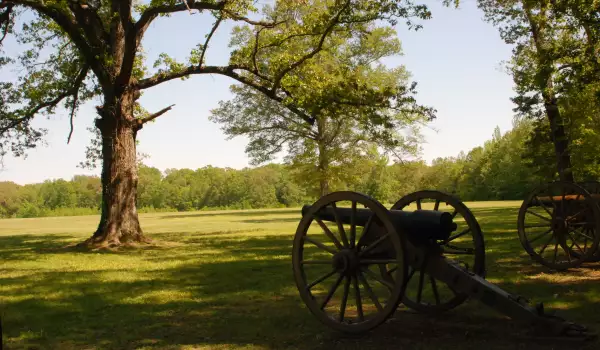Shiloh National Military Park

Shiloh National Military Park is located near the Mississippi in the town of Shiloh. This park keeps part of the history of the Civil War.
The battle of Shiloh is considered one of the first major battles in the West during the Civil War. The battle lasted two days, 6 and 7 April 1862 and in it were killed and injured over twenty-four thousand soldiers.
This battle laid to rest the six-month struggle for an important railway junction. These two days ended with a tactical victory for neither side, as Union troops held control of the battlefield, but were unable to follow the Confederate troops in their withdrawal.
From a strategic perspective, however, the armies of the Confederacy were heavily defeated. The battlefield is named in honor of Shiloh Church, located in Tennessee.
In mid-February 1862, the Union troops managed to gain many victories in the west, Mill Springs, Kentucky and counters in Henry and Donelson in Tennessee. These victories led to a breakthrough to the Tennessee River, where there were major railways.
Chief Commander of the Confederation of the West, General Albert Sidney Johnston, was forced to concentrate their forces around the small town of Corinth. In the early morning of April sixth Confederate soldiers attacked the Union troops by surprise, who numbered about forty thousand. Suddenly, the attackers lost coordination, and General Johnston was shot in the right leg, the wound proved fatal. The next morning the Union troops attacked the Confederate troops who were forced to return to Corinth.
The National Military Park was opened in December 1894. On the territory of Shiloh National Military Park is located Shiloh National Cemetery, which is located in the north-eastern part of the park. There, on an area of over twenty acres were buried about four thousand soldiers from the armies of the Union. The cemetery was established before the opening of the park - in 1866 when the end decision of the War Department was to create a battlefield cemetery at Shiloh.
To be buried there, were not only those killed in battle in April 1862, but also during the Tennessee River operation, was built the Pittsburgh National Cemetery, which in 1889 was renamed the Shiloh National Cemetery.
In the autumn of 1866 were taken out bodies of the dead from over six hundred locations around the battlefield, and around the Tennessee River. Wooden slabs that mark the graves were replaced in 1877 with granite slabs. High slabs are placed on the graves of soldiers whose names are known, and short square tiles are placed on the graves of fallen soldiers, whose names were never established. The territory of the cemetery has only two graves of Confederate soldiers.
On the territory of the Shiloh battlefield is preserved the prehistoric Native American section of the embankment (Shiloh Indian Mounds), which are historical landmarks. More than 800 years ago, this place was a city which was situated near the river Tennessee, at the eastern end of the Shiloh plateau. Some embankments had dozens of houses.
Six of the embankments are the basis for the construction of important buildings in the locality.
At Shiloh National Military Park many historical landmarks can be found. It stretches over four thousand two hundred acres.















